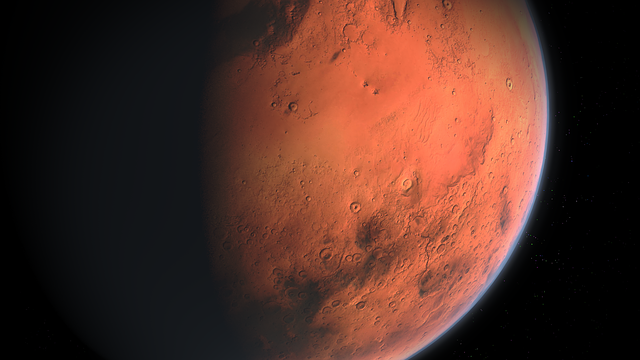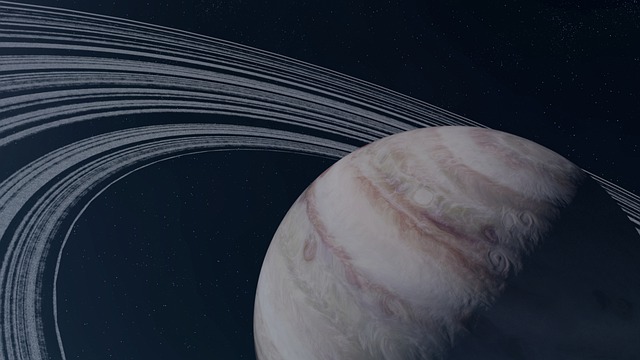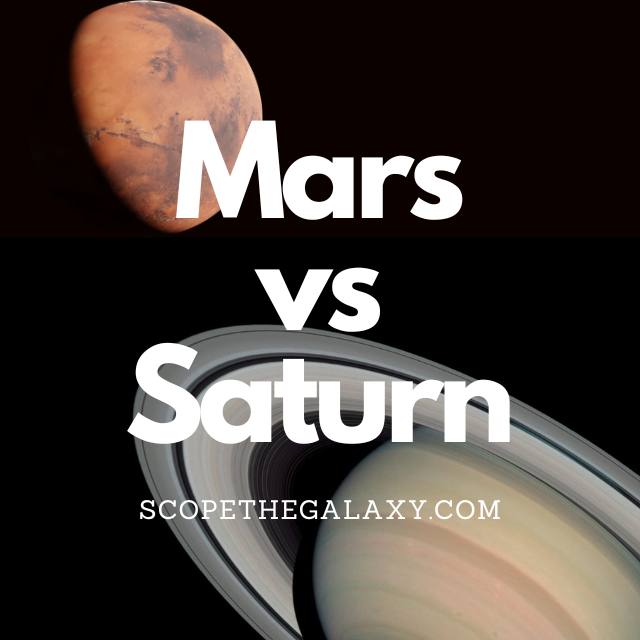*This post may contain affiliate links. This means we may make a commission if you purchase an item using one of our links*
The main differences between Mars and Saturn is that Saturn is the 6th farthest planet from the Sun whilst Mars is 4th, Saturn has 82 moons compared to Mars’ 2, Staurn is around 17 times bigger than Mars in diameter, Mars is warmer with a temperature of -67°C as opposed to Saturn’s -138°C and Saturn is a gas giant whilst Mars is a terrestrial planet.
There are a variety of other differences and the odd few similarities too so, continue reading if you want a more thorough breakdown of all these differences and similarities between the two.
What Is The Planet Mars?
Table of Contents

Mars, also known as the red planet and the celestial object that’s the front runner in our entire solar system to become a possible new home for us if terraformed. It is also the 4th farthest planet from the Sun and is one of 4 main line
terrestrial planets (not including Pluto) in our solar system.
This means that one year on Mars will take roughly 687 Earth days and a day on Mars is roughly the same as Earth at 24 hours and 37 minutes. It’s axial tilt is als very similar to that of Earth where it is positioned around 25 degrees to the right
It may not be the largest terrestrial world in our solar system as its diameter is only 6,779km but, it does have the most moons amongst the normals terrestrial planets here where two, namely Deimos and Phobos are currently orbiting the red planet.
Like Earth and the other terrestrial worlds, Mars does have an atmosphere, certainly more visible than that on Mercury but, when compared to Earth’s it is merely 1% of the volume on our home planet.
As a result it is more susceptible to larger debris striking its surface and is unable to trap in too much heat either. This is why it’s on the colder side with a temperature of around -65 degrees Celsius on average. On the contrary its core is significantly hotter at 1,350 degrees Celsius.
Mars is probably the most explored planet outside of our own, with a multitude of rovers like Sojourner (1997–1997), Opportunity (2004–2018), Spirit (2004–2010), Curiosity (2012–), and Perseverance (2021–) that have landed on the martian soil to explore it.
Billionaires like Elon Musk and even Jeff Bezos are trying for an oppurtunity to genuinley have astronauts land on the martian soil, possibly as early as 2029 so, Mars clearly has a lot interested in its terrain, as a potential subsitute for Earth in the future.
What Is The Planet Saturn?

Saturn is the second largest planet in our solar system, that has a multitude of rings surrounding its gaseous exterior. It’s also the 6th farthest planet from the Sun.
As Saturn falls under the gas giant moniker, the planet is mostly made up of gases. However, Saturn’s composition is a little different from Jupiter’s where its atmosphere is mixture of hydrogen and ices containing elements of Ammonia.
It’s core on the other hand is comprised of a dense core of nickel and iron, which is then surrounded by rocks compressed so strongly that it can tends to reach scorching hot temperatures of 11,700+ degrees celsius.
On the other hand, It’s gaseous atmosphere is far cooler. The exterior generally sits in the extreme sub zero range where Saturn’s temperatures is -138 degrees celsius.
This is generally constant throughout the yellow ringed giants day to day. In fact it’s much colder than even the coldest place on Earth, which would be Eastern Antarctic Plateau, Antarctica that hits -94 degrees Celsius, which is more than 40 degrees celsius warmer.
Being so large (116,460km), Saturn’s gravitational pull is obviously strong. That’s why over it’s 4.5 billion years of existence, beyond its rings this yellow gas giant has managed to accumulate 82 different moons along with other smaller interstellar debris that now orbit it.
In fact it’s largest moon Titan is literally bigger than one of the 8 planets orbiting the Sun, Mercury.
Saturn also orbits the Sun but, as the 6th farthest planet from it, it does mean a singular orbit will take it 29.4 Earth years to complete. In comparison to its axial orbit which only takes 10.7 hours, this is an extremely long time.
Similarities Between Mars And Saturn
Although Mars and Saturn don’t have too much in common, there are still a few elements that they do share, which includes the following:
- Both planets orbit the Sun in a circular pattern.
- Both have a hotter central core.
- Both are a spherical in shape.
- Both have multiple moons orbiting them.
Differences Between Mars And Saturn
In regards to the differences between these two, they include the below:
- Mars is a terrestrial planet whereas Staurn is a gas giant.
- Mars is mostly composed of iron, nickel, and sulfur as opposed to Saturn that is mostly composed of hydrogen and helium.
- Saturn has 82 moons as oppopsed to the 2 that Mars has.
- Mars is the warmer of the 2 planets with an average temeprature of -67 degrees celsius as opposed to Saturn’s -138 degrees Celsius temperature.
- On the other hand, Saturn does have a hotter core that averages 11,700 degrees Celsius unlike Mars’ 1,350 degrees Celsius.
- Mars has an axial tilt of 25 degrees whilst Saturn’s axial tilt is 27 degrees.
- Mars completes a day in 24 hours and 37 minutes as opposed to the 10 hours it takes Saturn to complete a daily rotation.
- Saturn is the 6th farthest planet from the Sun whereas Mars is the 4th farthest. As a result it takes Mars 687 days to orbit the Sun whilst Saturn does so in 29.4 years.
- Saturn has 7 rings around it as opposed to the 0 rings that orbit Mars.
- Saturn is significantly bigger than Mars with a diameter of 116,460km whilst Mars is only 6,779km.
- As a resut it’s no surprise that Saturn is heavier, with a mass of 5.683 × 10^26 kg as opposed to Mars’ 6.39 × 10^23 kg.
- Saturn is a pale yellow color whereas Mars is red.
- Mars is the denser of the two planets with a density of 3.93 g/cm³ whilst Saturn’s density is 0.687 g/cm³.
- Gravity on Saturn is 10.44 m/s² whereas Mars’ is much lower at 3.721 m/s².
Summary
Mars and Saturn are both part of the solar system but, based on their composition, size, temperature and a number of other factors, they aren’t all that similar despite both falling under the umbrella of a planet.
Mars is a terrestrial planet with potential of one day becoming our new home whereas Saturn is unlikely to ever become such an entity, so it’s no surprise that Mars and Saturn are as different as they are as only one has real potential in becoming habitable.

